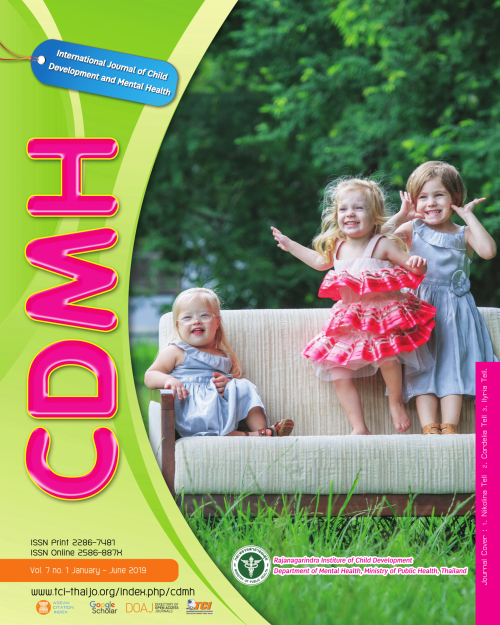Predicting depression from quality of life in school, Automatic negative thoughts and Anger management of upper–secondary school students Quality of life, automatic negative thoughts, anger management and depression
Main Article Content
Abstract
The purpose of this correlational research was to find the predictive ability of quality of life in school, automatic negative thought, and anger management on depression of adolescents in upper-secondary school students in the Bangkok area under management of the Office of the Basic Education Commission: (OBEC) in Bangkok area 1 in the academic year of 2017. Four hundred subjects were obtained by a stratified random sampling method. Data collection was done using 1) personal information, 2) the quality of life in school questionnaire, 3) children’s and adolescents’ automatic thought scale, 4) the anger management questionnaire, and 5) Health -Related Self Report: HRSR -The Diagnostic Screening Test for Depression in Thai Population. Data was analyzed in terms of percentage, mean, standard deviation, Pearson correlation coefficient and multiple regression-forward. It was found that there were two independent variables which co-predicted the changes of depression score by 32.3 percent at p< .05 level. The most powerful predictor was automatic negative thought, followed by anger management-‘anger control out’. Quality of life in school and the anger management-‘anger control in’ were rejected from the equation.
Article Details
![]()
Creative Commons License
This work is licensed under a Creative Commons Attribution-NonCommercial-No Derivatives 4.0 International (CC BY-NC-ND 4.0)
The authors retain copyright and permit the journal the copyright of first publication
Articles, once having passed the review process and accepted for publication in the CDMH Journal, are copyrighted under the CDMH Journal, Department of Mental Health, Ministry of Public Health. Please be aware distribution of CDMH Journal content for commercial purposes without permission is expressly prohibited. However, distribution with intent to educate, advocate, or spread awareness within the general public and research communities is permitted and encouraged with the understanding that the CDMH Journal Editorial Board do not hold jurisdiction or liability for any accompanying comments, text, or information from third parties, either in favor for or against the original article’s assertions, conclusions, methodology, or content.
References
APA-Press, Washington, DC CrossRef Google Scholar.
Arunakul, J. (2016). Adolescence Psychiatry. Bangkok: Parbpim Printing. (In Thai)
Beck, J.S. (1995). Cognitive therapy: basics and beyond. New York: The Guilford press.
Burney, D.M., & Kromrey, J. (2001). Initial development and score validation of the Adolescent Anger Rating Scale.
Educational and Psychological Measurement. 61(3), 446-460.
Deffenbacher, J.L., Oetting, E.R., Lynch, R.S., & Morris, C.D. (1996). The expression of anger and its consequences.
Behaviour Research and Therapy. 34(7), 575-590
Department of Mental Health, Ministry of Health. (2016). Annual Report. Bangkok: Bangkok Block. (In Thai)
Department of Mental Health, Ministry of Health. (2017). Annual Report. Bangkok: Lamom. (In Thai)
Forgays, D.G., Forgays, D.K., & Spielberger, C.D. (1997). Factor Structure of the State-Trait anger Expression
Inventory. Journal of Personality Assessment. 69(3), 497-507.
Greer, S. & Morris, T. (1975). Psychological attributes of women who develop breast cancer: a controlled study. J.
Psychosomatic Research.19 (2), 147-153.
Harburg, E., Blakelock, E.H., & Roeper, P.J. (1979). Resentful and Reflective Coping with Arbitrary Authority and Blood
Pressure: Detroit. Psychosomatic Medicine. 41(3), 189-202.
Harburg, E., Gleiberman, L., Russell, M, & Cooper, M. L. (1991). Anger-coping styles and blood pressure in black and
white males: Buffalo, New York. Psychosomatic Medicine. 53(2), 153-164.
Jamprakone, C. (2006). The effects of rational emotive behavior group counseling on anger assertive behavior of
adolescents. (Unpublished master's thesis). Burapha University, Chonburi, Thailand (In Thai)
Jozefiak, T., Larsson, B., & Wichstrøm, L. (2009). Changes in quality of life among Norwegian school children: a six-
month follow-up study. Health and Quality of Life Outcomes. 7(1), 7.
Kasantikul, D., Karnjanathanalers, N., Limsuwan, N., Thongtang, O., Vuthiganond, S., Khuangsirikul, V.,
Tantipiwatanakul, P., & Theramoke, V., (1997). Health-Related Self-Report (HRSR) Scale: The Diagnostic Screening
Test for Depression in Thai Population. Journal of the Medical Association of Thailand. 80(10), 647-656. (In Thai)
Kassinove, H. & Sukhodolsky, D. (1995). Anger Disorders: Basic Science and Practice Issues. Comprehesive Pediatric
Nursing. 18(3), 173-205.
Massayakong, S. (2011). The Quality of Life in schools of Upper Secondary Students in Bangkok Area. (Unpublished
master's thesis). Applied Statistics: NIDA: Bangkok. (In Thai)
Piyasilp, W. & Katuman, P. (2002). Child and Adolescent Psychiatry. Bangkok: Beyond Enterprise. (In Thai)
Schniering, C., & Rapee, R. (2002). Development and validation of a measure of children’s automatic thoughts: the
children’s automatic thoughts scale. Behaviour Research and Therapy, 40(9), 1091-1109.
Spielberger, C. D. (1988). Manual for the State-Trait Anger Expression Inventory. Odessa, FL: Psychological
Assessment Resources.
Spielberger, C., Crane, R. S., Kearns, W. D., Pellegrin, K. L., Rickman, R. L., & Johnson, E. H. (1991). Anger and
anxiety in essential hypertension. Stress and emotion, 14(19), 266-283.
Sunthornwipat, C. (1997). The development of students’ quality of life in school scale. (Unpublished master's thesis). Department of Educational Research, Graduate School, Chulalongkorn University, Bangkok. (In Thai)
Takebe, M., Takahashi, F., & Sato, H. (2015). Mediating Role of Anger Rumination in the Associations between
Mindfulness, Anger-In, and Trait Anger. Psychology, 6(08), 948-953.
Thapinta D., & Songmuang K. (2004). Children Automatic Thought Scale (CATS) Thai version. In Songmuang K. Negative Automatic thoughts in junior high school students (Unpublished master's thesis). Chiang Mai University,
Chiang Mai. (In Thai)
Vatanasin, D., Thapinta, D., Thompson, E. A., & Thungjaroenkul, P. (2012). Testing a Model of Depression Among Thai
Adolescents. Journal of Child and Adolescent Psychiatric Nursing, 25(4), 195-206. (In Thai)
WHO. (2017). Depression. Retrieved from https://www.thaidepression.com/ www/who_depress/3_who.pdf.
WHO. (2018). Adolescent development. Retrieved from https://www.who.int/maternal_
child_adolescent/topics/adolescence/development/en/
William Glasser, M. (2010). Reality Therapy: A New Approach to Psychiatry. New York, NY: HarperCollins.
Wongsuwan, T. (1999). Effects of group counseling based on rational emotive behavior therapy on anger of
adolescents in school. (Unpublished master's thesis). Chulalongkorn University,Bangkok. (In Thai)
Yamane, T. (1973). Statistics: An Introductory Analysis. (3rd ed.). New York: Harper and Row Publication.

